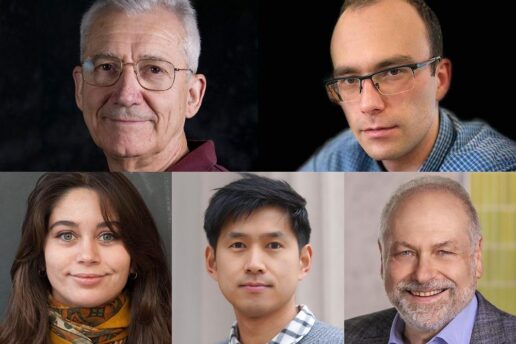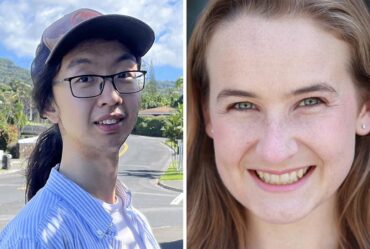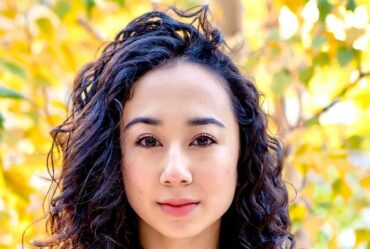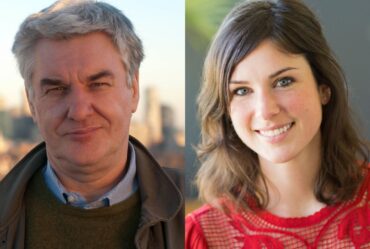
Five MIT affiliates receive awards from the American Physical Society
Professor Wit Busza, Instructor Karol Bacik, postdocs Cari Cesarotti and Chao Li, and Pablo Gaston Debenedetti SM ’81, PhD ’85 honored for contributions to physics.
The American Physical Society (APS) recently honored five MIT community members for their contributions to physics: Professor Wit Busza, Instructor Karol Bacik, postdocs Cari Cesarotti and Chao Li, and Pablo Gaston Debenedetti SM ’81, PhD ’85.
Tom W. Bonner Prize in Nuclear Physics
Wit Busza, the Francis L. Friedman Professor of Physics Emeritus, and a researcher in the Laboratory for Nuclear Science, was awarded the Tom W. Bonner Prize in Nuclear Physics “for pioneering work on multi-particle production in proton-nucleus and nucleus-nucleus collisions, including the discovery of participant scaling, and for the conception and leadership of the PHOBOS experiment.”
The prize recognizes outstanding experimental research in nuclear physics, including the development of a method, technique, or device that significantly contributes to nuclear physics research.
When two protons or nuclei traveling at close to the speed of light collide, a vast number of particles are created. It is a distinct example of energy converting to mass. As an example, when lead nuclei collide in the highest-energy colliders, one often sees over 10,000 protons, neutrons, antiprotons, pi-mesons, etc. streaming out from the tiny volume where the collision took place.
“It’s amazing if you consider that this volume is no larger than that of a mere 100 or so of such particles,” Busza says. “The question arises: What exactly is this extremely hot (more than a billion times higher temperature than the surface of the sun) and super dense stuff, which was produced in the collision, before it evolved into the observed large number of created particles? It is a particularly interesting question since we think it is the same stuff, named the quark-gluon plasma, out of which most of our universe was made at about 10 microseconds after the Big Bang.”
Busza is best known for influential pA experiments at Fermilab, in which he discovered participant scaling and obtained, together with Alfred Goldhaber, the first data-based estimate of the energy density that will be produced in the future Relativistic Heavy Ion Collider (RHIC). He’s also known for originating and leading the PHOBOS experiment, which together with the other RHIC experiments discovered a strongly interacting quantum chromodynamics liquid (at the time named “strongly interacting Quark-Gluon Plasma”).
Andreas Acrivos Dissertation Award in Fluid Dynamics
Instructor of applied mathematics Karol Bacik received the American Physical Society’s 2023 Andreas Acrivos Dissertation Award in Fluid Dynamics “for an elegant study of dune-dune repulsion and dune-obstacle interaction using laboratory experiments, data analysis, and mathematical modeling, elucidating the intricate feedback between sediment dynamics and fluid mechanics.”
His groundbreaking experimental and theoretical work on the dynamics of underwater sand dunes was done at the University of Cambridge, where he received his PhD in 2021. From 2021-23 Bacik was a research associate at the University of Bath, where he investigated a range of problems in active flows and mathematical biology.
Bacik’s award lecture will be at the 76th Annual Meeting of the APS Division of Fluid Dynamics on Nov. 21.
J.J. and Noriko Sakurai Dissertation Award in Theoretical Particle Physics
Cari Cesarotti, a postdoc at the Center for Theoretical Physics, received the 2023 J.J. and Noriko Sakurai Dissertation Award in Theoretical Particle Physics “for exploration of collider signals of physics beyond the Standard Model, including the development and assessment of a novel collider event-shape observable tailored for distinguishing strongly coupled hidden sectors from background, and studies of physics at future muon accelerators and colliders.”
Cesarotti’s research program works toward discovering physics beyond the Standard Model in robust ways. This includes developing novel observables, model-building new physics scenarios, and advancing the physics case for future experiments. She is also an active member of the muon collider community. Cesarotti completed her BA in physics at Cornell University in 2017, and completed her dissertation in high-energy particle theory under Professor Matthew Reece at Harvard University in 2022.
Outstanding Doctoral Thesis Research in Beam Physics Award
Research Laboratory of Electronics (RLE) postdoc Chao Li received the 2023 Outstanding Doctoral Thesis Research in Beam Physics Award “for seminal and highly creative contributions to the development of microfabricated, miniature atomic beam technology and the invention of new chip-scale techniques that enable precise and targeted delivery of neutral atoms.”
With MIT RLE’s Quantum Photonics and AI Group, Li is exploring the use of large-scale photonic integrated circuits for the fast and coherent control of various types of qubits, such as color centers in diamonds, trapped neutral atoms, and ions. Li earned his bachelor’s degree from Jilin University in 2016, and his PhD from Georgia Tech in 2022, both in physics.
Aneesur Rahman Prize for Computational Physics
Pablo Gaston Debenedetti SM ’81, PhD ’85, an alumnus of the MIT Department of Chemical Engineering who is currently the Princeton University dean for research, received the 2023 Aneesur Rahman Prize for Computational Physics “for seminal contributions to the science of supercooled liquids and glasses, water, and aqueous solutions, through ground-breaking simulations.”
Debenedetti’s research interests include supercooled water, glasses, protein thermodynamics, nucleation, metastability, the origin of biological homochirality, and hydrophobicity. His most important results, obtained with students and collaborators, include providing rigorous computational proof of the existence of a liquid-liquid transition in several water models, and demonstrating the relationship between structural order and water’s anomalies.


